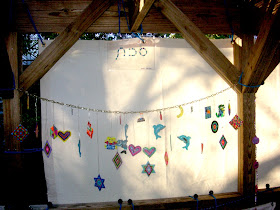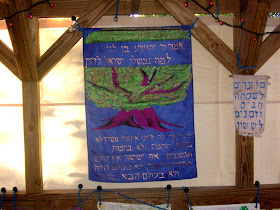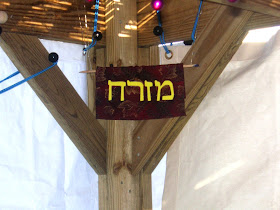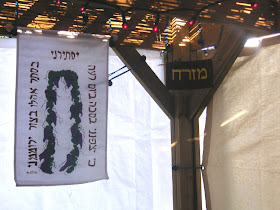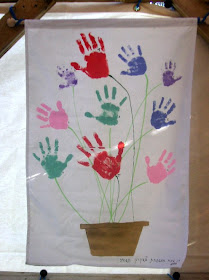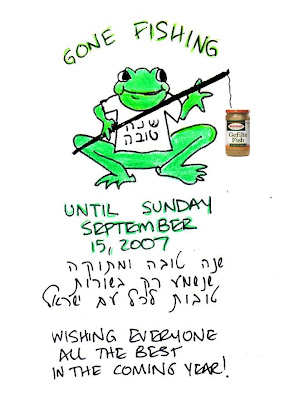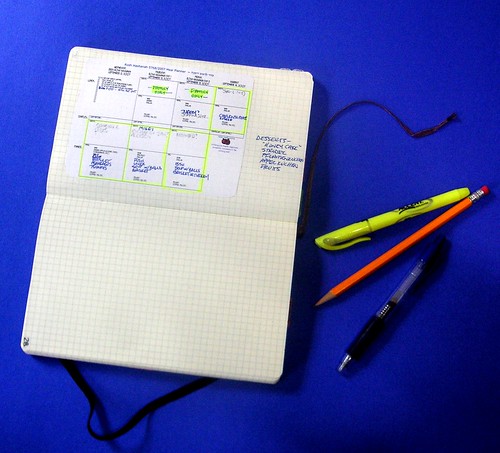That's
T for the Hebrew month of
Tishrei. And 10, as in 10 days.
Rosh Hashanah starts on the first day of Tishrei. This year (2007, or 5768, depending on which calendar you're using) it begins on Wednesday evening, September 12. Counting TODAY, there are
10 days left until Rosh Hashanah.
What follows is my own non-exhaustive, imperfectly-edited collection of lists of things to
freak out about consider before the Jewish ("high") holidays. I'm sharing them because it can be helpful to read such a list (not to adopt it completely, but rather) as a trigger to remember things that might otherwise fall through the cracks.
The list items are in no particular order.
If you don't find this type of exercise helpful, please move along. This is a ridiculously long post.
Spiritual preparation is not in the scope of this message. The purpose of these lists is to focus on the physical stuff to clear our heads for the Big Stuff to come.
I guess you could call this an exercise in Getting Jewish Things Done (jGTD? gJtd?)
(Disclaimers:
Since this is my list, it is geared to our Ashkenazi, non-chassidic, yekkish (German-Jewish), orthodox family living outside-of-Israel (in the U.S.) Everyone's list will vary with their circumstances and customs.
We're hosts, not guests. If you're traveling, there will be scads of other stuff to do, such as acquiring hostess gifts, packing, etc. Personally, I'd rather cook for a month than pack for a week.
Please consult your local halachic authority about anything that differs from what you normally do. I'm not any sort of halachic authority. I don't even play one on t.v.
I'm not trying to tell anyone (other than my recalcitrant self) what to do. My goal is to help those who want to do these things remember that the time to do them is nigh.
Non-Jews are hereby invited to skip this post. Or you can stay and just smile and nod sympathetically like we do in December. Really, though, I can't imagine it holds any interest to those who aren't in this particular foxhole. Due to time constraints, I'm not going to translate the Jewish and Hebrew terms much. The OU.org website is a fount of legitimate and useful information, such as their Jewish Holiday Calendar overview.
I'm sure I've forgotten at least something vital. Please don't immerse this list in water or hold it while running with scissors. I'm cold, go put on a sweater... )
Scheduling notes for Rosh Hashanah
Starts Wednesday, September 12, 2007 before sunset, officially ends on Friday night, September 14, but since that coincides with Shabbat, it
effectively ends Saturday night, September 15.
We affectionately (yet inaccurately) call this phenomenon (when a two-day holiday gets extended due to its sharing a time border with Shabbat) a "Three Day Chag".
Rosh Hashanah is two days long, even for those who live in Israel.
With the exception of Rosh Hashanah, those who live in Israel celebrate only the first day of the double-day holidays. Thus, they are unaccustomed to the "Three Day Chag" situation, as it only comes up for them when Rosh Hashanah falls on a Wednesday night, as it does this year.
Those of us who live outside Israel experience this more often.
Things to do before Rosh Hashanah
- Start a list of questions to ask the Rabbi, even if you don't have any yet. Try to ask questions early, as his schedule includes all that we have to do, along with a dozen high-pressure, high-profile public presentations and a gazillion other details.
If for whatever reason the questions don't get answered (or asked) before/during this Tishrei (for example, due to discovering a workaround that avoids having to ask), if they are written down, you can ask them next month, in preparation for 5769.
If they're not written down, they'll fall victim to post-chag amnesia.
- Slichot!! Find the Slichot machzorim, put the date (depending on your minhag) on calendar. We have them this coming Saturday night, September 8, 2007.
Find out the time - is it midnight? 11:pm? 1:am? I don't know why, but every year we forget this.
- Verify that there is a box of matzah for the three eruv tavshilins that are required this month. (I have a box still leftover from Pesach this year. Mustn't allow anyone near it.)
- Get the holiday schedule, including the shul's davening times entered on the family's calendar.
Make sure the shul schedule is available in hard-copy somewhere public. Ours is in the reference binder on our refrigerator. Enter the candle lighting times onto calendar - especially if you use an electronic one.
- Prepare an Eruv Tavshilin on Wednesday, September 12, 2007 during the day.
- We won't have many weekdays this month, so it is helpful to pre-pay bills as much as possible, so they won't pile up.
- Look into chessed opportunities particular to the season - blowing shofar for hospital patients, inviting overlooked local residents (especially singles and those new to the area), delivering Yom Tov food, etc. Schedule these now before the quicksand of the schedule buries the opportunities.
- Buy honey for baking and for serving. We dip the bread in honey for every Yom Tov meal from Rosh Hashana through Shemini Atzeret.
This is a huge concession on the part of my husband, who considers honey a Class 3 Controlled Substance. He hates the mess. Even outside in the Sukkah.
Note: This video was made by someone else, who has a better sense of humor than my husband when it comes to honey.
A family tradition has developed around this, where the kids goad him on about it, with exaggerated reveling in this custom as though it were halacha. It is very effective: their eyes dance and my husband's jaw sets at the mere mention of honey.
- Buy or cut flowers for the table.
- Get an article of new clothing or jewelry.
- Check that everyone has enough outfits and undergarments including new or at least run-free stockings!) that fit for three days of synagogue and company meals.
Remember that the kids probably grew over the Summer. Inspect these clothes for missing buttons, stains, etc. Set them aside to minimize the day-of-chag screams of "Hey! That was MY skirt. Who told you you could wear it today? ......EEEEEEma!"
- Dry cleaning submitted and picked up. Do you know where your (husband's) kittel is?
- Obtain whatever Simanim your family uses.
- Obtain "New Fruit" (something you haven't eaten yet this year, to justify saying shehechiyanu on the second day)
- Medication/vitamins for the month (consulting your local halachic authority as necessary if there is a need to take the on Yom Tov.)
- Buy tons of eggs. Everything, including the eruv tavshilin will use eggs. Can always make egg salad or serve them hard boiled. Eggs last a while.
- Establish a set place for the onslaught of tzedakah mail that comes with this season. Either make special folder in your inbox for it, or, if you use a tickler file, pick a date to make decisions and write checks.
- Schedule cemetery visits.
- Locate the machzorim (specialized holiday prayer books). Do they need covers? (Helpful when saving/finding seats in a roomful of identical books, and for their likely return if they get left behind.)
Does the family need any new ones for kids who are newly old enough to read from them?
I like to prepare my machzor with a few tissues tucked into the cover, and with a cloth napkin (because we bow to the floor, but not on a bare floor) for Yom Kippur.
- List of family members and friends to call and wish good new year/yom tov.
- Wednesday: Turn of alarm clocks!
- Check if we need any new dishes/serving platters. Set aside things to tovel (immerse in the dishes mikvah before first use) and some time to do that. (No, driving around with the vegetable peelers in the minivan for three weeks doesn't obviate the need to actually dunk them. )
Also, might be able to think of a substitute/friend to borrow from/etc. if you realize it now and don't want to purchase or don't have the resources (energy, time, money, decision making skills....) to buy.
- Especially for mothers: try to schedule some time alone for Rosh Hashanah/Yom Kippur-type thoughts, in the midst of all the hectic planning
- Acquire hostess gifts. Stockpile a few extra bottles of wine and a few pareve treats (not nuts, just in case someone has the minhag/custom to avoid them on Rosh Hashana) just in case.
- Get haircuts
- List menus, even if only a blank template that says "Wine - Simanim - Bread - Beverages - Fish Plates - Soup - Main course + 2 sides - Dessert - Coffee/Tea" for each of the meals of the holiday. I use pre-printed mailing labels for this. (Not likely to have this downloadable for 5768, but I'll try for next year to have them here.)
- Make a list of guests to invite. Invite them.
- Make the guest beds (even if not expecting any - you never know who will have to stay over, and a made bed doesn't have an expiration date) and check the overnight guest accommodations (clean towels, etc.)
- Check supply of/iron/purchase/prepare table linens.
- Start a shopping list
- Prepare any blog posts, e-mail messages or voice mail announcements to warn people you'll be unavailable for certain dates.
- Purchase seat reservations at shul.
- Start a bag for things to bring and (if allowed) keep at shul. For the children: diapers, toys, sweets. Will still need to add snacks for the kids on the day of...
- Make provisions for kaparrot. Although in English that word contains 'parrot', we don't use birds at all just $.
- Pack a stroller bag. (Uh oh! I just realized: we need a new stroller! The wheel housing broke a few weeks ago. Oy.)
- Arrange/pay for babysitting for Rosh Hashanah and Yom Kippur.
- Any children's art projects made from now until Sukkot should be evaluated as potential Sukkah decorations. If there is a young child who doesn't attend school, make sure that child has a few pictures hung in the sukkah, so she/he won't be left out when everyone points out what they made.
If necessary, anything can be 'laminated' by being slipped in a page protector. There should be something hanging in the sukkah from every child.
- Make a plan for tidying up (at least the public rooms) that doesn't require doing much on erev chag.
- Print some extra labels for food that is likely to be prepared during the chaggim. (Consult rabbi if this is okay and how to do it.)
- This is a good time to have an empty inbox. That may not be realistic, but any extra moments spent toward this goal will be appreciated.
- Clean out refrigerator and freezer to make space for Yom tov cooking. Cook as much as possible before the date in advance.
- We don't use bread for tashlich, but if you do, you might want to set some aside.
- Can't hurt to have extra apples and honey and pomegranates, etc. to serve as emergency hostess gifts. Can always use them in salads if not needed.
- It's not a minhag, but we like to serve the 7 kinds at the Rosh Hashana table.
Need to acquire these. (Note to self: put barley on the shopping list.)
For a quick and tasty barley dish, prepare with a jar of spicy salsa. (Note to self: put a jar of salsa on the shopping list.)
- Start baking round challot.
- We don't send cards, but appreciate those we receive. We display them on a shelf until sukkot, when they'll morph into sukkah decorations. Still helpful to have a few cards on hand, in case need to reciprocate with someone who would be put off by not receiving a card.
- Candles: Regular candles. In four weeks, have 10 candle lightings. Also check the stock of yartzheit candles both for transferring flame and for yizkor if necessary. (Thank G-d, we don't need them for this.) Have I mentioned there will be three 3-day chaggim chutz l'aretz?
- Think about the status of the sukka from last year. Is anything broken? Can it be ordered? Need new scach?
- Wednesday afternoon: Set cellphones, Blackberries, Palm pdas, and cordless phones up to charge, otherwise their power will drain over the next 3-4 days.
- Wednesday afternoon: Run the garbage disposals before candle lighting time, so the sink drains will be empty and clear.
- Polish silver (If you're into that sort of thing. Around here, we're fans of tarnish, calling it "patina".)
- Wednesday (sometime): Empty the answering machine/voice mail so it won't overflow over the break.
- Move the laundry to the dryer, leaving nothing in the washer to mildew over the break.
- Try to have at least one dish to prepare with the kids, so they have sweet holiday preparation memories and no false advertising about the level of preparation required to make a holiday work.
- Buy non-perishables NOW if haven't done so already. Also not a bad idea to have some emergency cake mixes, salad dressings, jarred sauces, etc. just in case homemade isn't possible.
- Stock the refrigerator and freezer with ingredients as much as possible. Try to do a bit each day.
- If you "do" GTD, try to get a weekly review done before Rosh Hashanah, but don't expect to do another until October. Brace yourself for October's to be a doozy.
Scheduling notes for Yom Kippur
Starts Friday, September 21, 2007 before sunset,
ends Saturday night, September 22. It's a special one this year, because it falls on Shabbat, although that has little impact on the preparations for it.
Things to do before Yom Kippur
- Seuda Hamafseket - the meal before the fast. Write in bold the time it should end. Think about the menu. We do a carbo-loading menu for this, just like the runners of the Boston Marathon do to prepare. (pasta, but not beer)
- Arrange for Break-the-fast food. (We bring it to shul.)
- Find the time to really ask a mechila from people - especially from family members, not just a quick question while running to shul on the way to Kol Nidre, but actual time to really ask and receive forgiveness from one another.
- Verify that everyone has non-leather shoes that fit. This can be a problem for the girls who wore sandals all Summer and their sneakers might not still fit.
- Mark on the calendar a reminder to drink a lot of water on the days before the fast.
- If you quit caffeine before fasting (to make it easier/avoid headaches) then write that reminder on the calendar, too.
- Make honey cake or a reasonable imposter for erev Yom Kippur, where we ask for it, in the hopes that it will be the only time that year where we need to ask for food.
- If you or a family member is pregnant, nursing or anticipates other health issues, ask the rabbi how to handle fasting, and how or when to break the fast if necessary.
Scheduling notes for Sukkot and Shemini Atzeret
This one's a bit more complicated, schedule-wise. If you know the score, or if you don't care, I recommend skipping this explanation and its headache-inducing effects.
The first two days of Sukkot are a double-day-if-outside-of-Israel, work-restricted holiday. ("Yom tov")
Sukkot is technically seven days long, but it is always immediately followed by another (double-day-if-outside-of-Israel, work-restricted) holiday, called "
Shemini Atzeret". This means that we can't take down the sukkah, write, shop, do laundry, etc. until after
Shemini Atzeret.
This makes Sukkot feel like it is nine days long for non-Israelis, and eight days long for those who live in Israel.
Since the Israelis celebrate
Shemini Atzeret in one day, that day is both Shemini Atzeret and Simchat Torah for them. For the rest of us, Simchat Torah is celebrated on the second day of Shemini Atzeret, the day that feels like the ninth day of Sukkot. But, really, there are only seven days of Sukkot.
The 3rd through 7th days are also Sukkot, but these days are called "chol hamoed" (a somewhat oxymoronic term, meaning something like "everyday holiday days".) These days between the two sets of double-day-if-outside-Israel, work-restrictive holidays have their own rules. For jGTD purposes, the impact on the to-do list for these intermediate days is minimal.
With me so far? Good. Then you're ready to kick it up a notch. It gets even more complicated. No, I'm not making this up.
This year, however, the third day of sukkot is one of those Shabbat days that hugs the first two holiday days. And, this year, Shemini Atzeret's two days also bump right up into a Shabbat.
Thus, there are two weeks of Wednesday night until Saturday night "Three Day Chags" this year. The 9th day of the whole Sukkot-Shemini Atzeret stretch end on Friday at sunset, when Shabbat begins.
So, this year, Sukkot, which is always technically seven days long, seems like ten days long. Some people (inaccurately, but forgivably, because by then we're all exhausted) call these the "last days of Sukkot".
This makes sense (even though it's wrong) to most of us, because the schedule for Sukkot looks a lot like the schedule for Passover, in that it is a holiday sandwich, with intermediate days ("chol hamoed") in the middle, and double-day-if-outside-of-Israel, work-restrictive holidays on either end. (Make that sandwich with matzah on Passover, please.)
On the seventh and last real day of Sukkot, there is yet another holiday called "
Hoshanah Rabbah". It follows the chol hamoed, not-completely-restrictive rules of the rest of the intermediate days of Sukkot, and has minimal planning impact on the schedule (mostly involving remembering to bring the extra willow leaves to synagogue that morning, and to expect a very long service that day - therefore a late lunch.)
So, for scheduling purposes and
to summarize (
If you read the above, you can understand my motivation for doing so), this year, Sukkot can be broken into three sections.
These dates are specific to those living outside of Israel:
- The (work-restricted) first days of Sukkot start Wednesday September 26, 2007 before sunset and, officially end on Friday night, September 28, but since that coincides with Shabbat, they effectively end Saturday night, Septemeber 29th.
- The (less restrictive) intermediate days of Sukkot (really start with Shabbat on the 29th, but Shabbat has its own restrictions) end on Wednesday night, October 3rd.
- The (work-restricted) Shemini Atzeret start Wednesday October 3, 2007 before sunset and officially end on Friday night, October 5, but since that coincides with Shabbat, they effectively end Saturday night, October 6th)
Things to do before Sukkot and Shemini Atzeret
- (Many of the same things that are on the list for Rosh Hashanah apply to Sukkot and Shmini Atzeret. I won't repeat them here, rather will say to check that list also...)
- Prepare an Eruv Tavshilin during daytime on each of the Wednesdays before Yom Tov.
- Mow the yard, at least where the sukkah is going to be. (Woot! As of last year, we now have the sukkah on the porch!!)
- Replace broken outdoor lightbulbs.
- Order any hardware for the sukkah that is broken or missing.
- Was it windy last year? Do you need more scach? Order it now.
- Shop for/order lulav and etrog set(s)
- Make sure the pathway to the sukkah is company ready (at best) or not a hazzard (at a minimum).
- If your rabbi/shul/minhag allows drinking on Simchat Torah, stock up on liquor.
- Plan for simpler foods and fewer courses on Simchat Torah. People will be hungry, but patience will be at a minimum. There are likely to be many leftovers available by then.
General guidelines for all of the month of Tishrei
Breathe
Get real. This is a month with 3 "Three Day Chag"s and 2 fast days in four weeks. There are going to be some mistakes. There are going to be some broken dishes. At least one kugel will burn. There will be stress. Expect it, and you can meet it, face-to-face. The stress that sneaks up on you is the real villian.
Try to find time to think Yomim Nora'im (High Holiday) type thoughts.
The food is important, but it isn't about the food.
If a guest (or anyone) offers help, accept it. This is a marathon; we have to pace ourselves. If nobody offers, ask for help.
Prevent burnout by firmly (but kindly) demanding that family members give you the help you need, even if that help is in the form of, "Please, will everyone leave the kitchen for a couple of hours so Mommy can keep track of the number of eggs in her recipes."
Don't get overwhelmed. Remember to breathe, and take breaks. The goal is not to be a drudge, even though some drugery is called for. Find ways to make tedious tasks joyful as possible, such as listening to music, setting aside a favorite yom tov treat just for Mommy, using a headset telephone to phone a friend while chopping vegetables, etc.
Hire help if necessary.
If you have a like-minded friend, even if across country or the world, make time to call and set a kvetch timer. 20 minutes of shared hassles become anecdotes, not whining. Made better in the retelling, just to know you have an audience, even a retrofit one.
Close the kitchen to snackers during cooking hours. It's helpful to have something they can take elsewhere - like outside - to nosh.
Loose ends
In your copious spare time (ha!) review the laws of cooking on Yom Tov. Knowing what you can prepare during the holiday and what needs to be done before-hand will help with prioritization.
If possible, bulk-prepare ingredients with electric devices before the holiday begins, rather than spending holiday time preparing foods manually.
For example, I like to measure the flour for certain recipes by weight. If I know in advance that I'll be making certain recipes on Yom tov, it helps to have it weighed in a paper bag before chag begins, rather than having to approximate the amount of flour in a manner I'm not accustomed to using, that will likely yield unpredictable results. If I need matzah meal, I could bang it up with a rolling pin on Yom tov, but I'd rather prepare some in a minute and a half in the food processor the day before. I can mix cake batter by hand, but much prefer to use the standing mixer, even if it means freezing the cake for part of the week.
Stock up on staples of paper goods - garbage bags, paper towels. They're not perishable.
Tearing paper towels is a great task for little kids. It's tedious and time consuming for adults, but the kids like it. They can't fail at this: If the towel tears, who cares? Now that school's almost in session, the kindergarten teachers will appreciate the cardboard tubes.
Make sure there is enough kleenex (doubles as pre-torn toilet paper) DIAPERS and wipes.
Must keep up with laundry, or have a strategy for doing so during the few scarce weekdays in September.
September is nuts this year. Imagine the calendar in the food processor. This coming Sunday is the last normal weekend until the second week of October.
The Sunday after Rosh Hashanah, September 16, 2007, is a fast day, so don't plan any heavy lifting for that day.
Realize that the all the schools, community organizations and birthday parties will pile on on that Sunday after Yom Kippur. Plan a Defensive Calendar Stategy now.
At least (for those of us in the USA), we have some Sundays for catching up. Resist the urge to schedule much on any of the Sundays until 10/14 because there will be much to do.
"One Company Meal Between Sleeps"
We started a family policy over a dozen years ago, of "
one company meal between sleeps." This means that (unless it is an emergency)
we invite guests for either lunch or dinner on a given Yom tov day, but not both. This allows us to relax with the guests, and experience the meal without hurry and without burnout.
Before we instituted this policy, sometimes we were still clearing the table from lunch when the dinner guests started to arrive. Yom tov meals are supposed to be served b'simcha, not through clenched teeth. If the schedule is too grueling, then the fancy roast might as well be gruel.
Deciding far in advance which meal each day will be the "one company meal between sleeps" allows the family to accept invitations to be guests at someone else's table for the other meal.
Accept invitations sparingly, to keep the fatigue to a minimum. Being a guest "on your best behavior" can be tiring, too.
We like to serve a light menu at the family-only meals. This lightens the burdens of cleaning and setting up, and it allows time for naps and digestion. It also gives the children an opportunity to share their divrei Torah at a private meal.
Emphasize the parts of entertaining (and of the whole holiday season) that you like best, and that give your family the most joy. Yes, all that is required
is required. But extra flourishes should come from the heart. The
Pareto Principle applies to kugels and honey cakes, too.
Holiday Manuals
I keep a binder for each major holiday season, where I put the lists, a few package labels, my notes, receipts, and recipes pertaining to that holiday. I have fun with them, giving them titles and a colorful picture on the cover.
Some of the titles include "There's a Leaf in My Soup: A Manual for Sukkot", "MiShenichnas Adar: A Manual for Purim", and "You're Not Making This Fun For Me: A Manual for Pesach".
People invariably exclaim, "Oooo, you're
so organized!" when they see the manuals on the shelf, but really, they're just a place to hold a random bunch of printouts and receipts. Half of them have almost no internal order at all. Toss one together, and see if your guests don't say the same thing.
For menu inspiration check the various
Kosher Cooking Carnivals. Print a few extra recipes that appeal to you and toss it in the appropriate folder/binder/shelf, if not for this year, then maybe for the next.
When Tishrei is over, sit down and do a complete "brain dump to paper" about what worked and what didn't. Put this list, along with the receipts, recipe print-outs and whatever other holiday planning detritus you can find, in the binder. Next year, you'll be another year wiser and more experienced, and you'll have the binder as evidence to prove it!
Save receipts. They can help make up next year's shopping list.
(I plan to print a copy of this blog post and stick it in the Manual for next year.)
A word on Simcha and to-do-lists
Simcha, the watch-word for Sukkot, is roughly translated as joy. Rather than a hedonistic joyfulness, simcha is the expression of the joy of engaging in mitzvot (G-d's commandments).
Sukkot is called "Zman Simchateinu", the time of our joy. Similarly, Passover is called the "time of our freedom" and Shavuot the "time of the giving of the Torah".
All three of pilgrimage holidays are supposed to be joyful, but simcha receives extra emphasis on Sukkot. Tradition's formulae for jumpstarting the holiday simcha involve sanctifying physical enjoyments, such as drinking wine, eating meat, and receiving new clothing or Jewelry in anticipation of the holiday.
Much is written (of course) from a Jewish perspective, about the meaning and implementation of holiday simcha. However, I enjoyed some recent insight on this from a secular source.
Gretchen Rubin, a writer empirically developing her own personal Theory of Happiness, blogs about her "research" experiences at
The Happiness Project.
Last week, she posted her "Third Splendid Truth". She states that happiness is a four-staged process:
anticipation, savoring, expression, and reflection.
Her model can give us a hint about maximizing our holiday simcha (
a concept not identical with happiness, but work with me here...) 'Anticipation' and 'expression' are nearly unavoidable, given all that must be done to prepare for and accomplish the tasks required on the holiday.
'Savoring' and 'reflection', however, require conscious effort lest they be neglected. 'Savoring' can't happen in an atmosphere of burnout. Savoring is the antithesis of stress.
I posit that efforts undertaken to reduce stress are a necessary part of the mitzvah of simcha on the holidays.
The point of all this list-making is to reduce stress. The lists are tools that are intended to help with at least three of Gretchen's four requirements. 'List-making is nearly synonymous with "
anticipation". Lists give us control and reduce stress so that the essence of the holiday can be
savored.
Reflection is inherrent in the debriefing, note-taking, and list-making that recommended after the holiday events.
If the lists induce stress rather than relieve it, then they are broken tools. Throw them out, replace them with something that works, or learn to use them properly. Don't let them injure you. (
Use eye protection if necessary.)
May your name be inscribed and sealed in the Book of Life and for all the best in the coming year.So, what's on your list?
Related posts:




 It's helpful to mark the path to the sukkah well, to avoid losing or frustrating guests.
It's helpful to mark the path to the sukkah well, to avoid losing or frustrating guests. 




